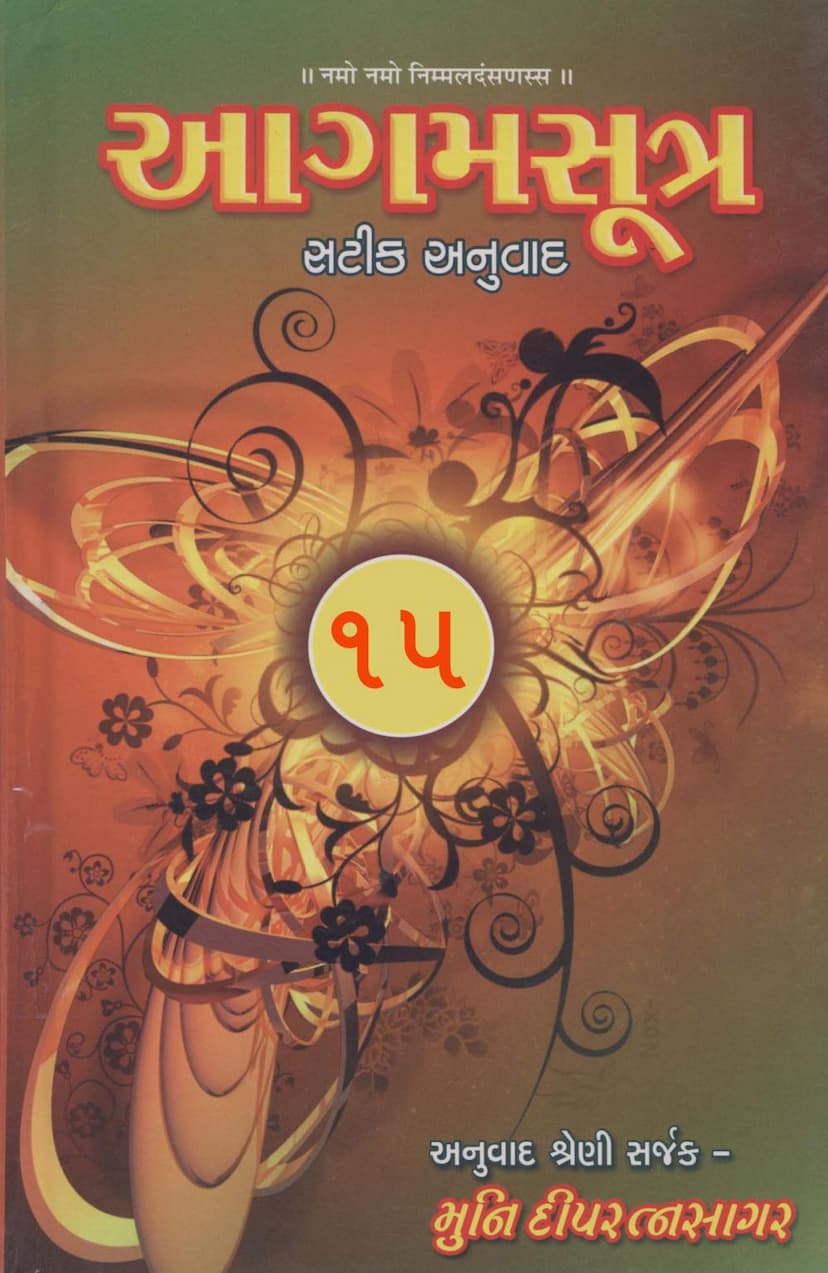Agam 09 Anuttaropapatik Sutra Satik Gujarati Anuvad
Added to library: September 1, 2025

Summary
This document is a partial Gujarati translation of the Anuttaropapātikadaśā (The State of Those Born in the Highest Realms), which is the ninth Anga (canonical scripture) of the Jain Agamas. It is part of a larger series titled "Agam 09 Anuttaropapatik Sutra Satik Gujarati Anuvad" published by Deepratnasagar, with Muni Dipratnasagar credited as the translator.
Here's a breakdown of the key information presented in the provided pages:
Book and Series Information:
- Title: Agam 09 Anuttaropapatik Sutra Satik Gujarati Anuvad (Agam 09: Anuttaropapātik Sutra with Commentary: Gujarati Translation)
- Author/Translator: Muni Dipratnasagar (also referred to as Deepratnasagar)
- Publisher: Deepratnasagar
- Series: This is part of a larger "Agam Satik Anuvad" (Agam with Commentary Translation) series. This specific volume appears to be part of "Bhag - 15" (Part - 15) of a larger set.
- Scope: The series aims to provide a complete Gujarati translation with commentary for several key Agamas, including Upāsakadaśā, Antakṛtdaśā, Anuttaropapātikadaśā, and Praśna Vyākaraṇa.
Dedication and Acknowledgements:
- The publication is dedicated to Pujya Acharya Shri Ruchakchandra Surishwarji M. and Pujya Acharya Shri Harshasagarsuriji M..
- Significant financial support for this translation work came from Shri Athwalines Jain Shwetambar Murtipujak Sangh and Shri Seth Phoolchand Kalyanchnad Trust, Surat, as well as numerous other Jain sanghs (communities/organizations) and individuals listed as "Dravyā Sahāyakō" (Financial Contributors). This highlights the collaborative effort and the importance placed on making these scriptures accessible.
Publisher's Publications:
Pages 8-15 detail the extensive publications by the publisher, showcasing a vast collection of Jain literature. This includes:
- Original Agams (Mūla): 49 publications, with 45 Agamas printed as separate books.
- Gujarati Translation of Agams: 40 publications, an "Akṣaraśaḥ Anuvad" (literal translation) of all 45 Agamas.
- Agams with Commentary (Satik): 46 publications, a voluminous work covering Niryuktis, Vrttis, Chūrṇis, and Bhashyas.
- Agam Subject Index: A detailed index of subjects within the Agamas.
- Agam Glossary (Sakkōśa): A comprehensive dictionary of Agamic terms with references.
- Agam Name Glossary (Nāmakośa): A dictionary of names and characters appearing in the Agamas.
- Hindi Translation of Agams: 12 volumes, a more extensive translation than the Gujarati one.
- Agam Kathānuyoga: A collection of stories and narratives from the Agamas.
- Various Ritual and Puja Guides: Books on specific pujas, rituals for initiation, death ceremonies, etc.
- Grammar, Commentary, Philosophy, and Prayer Literature: A wide range of works on Jain grammar, discourses, Tattvartha Sutra, and devotional literature.
Content of the Anuttaropapātikadaśā Translation (Pages 16-20):
This section provides a glimpse into the content of the Anuttaropapātikadaśā itself.
- Definition: It defines Anuttara as the highest, and Upapātika as referring to birth in specific celestial mansions (vimānas). The daśā (state or condition) describes those who are born in these highest realms. The text refers to the Jñātādharmakathā for a more detailed explanation of the daśā.
- Structure: The Anuttaropapātikadaśā is divided into three varga (classes or sections), and each varga has several adhyayana (chapters or lessons).
- Varga 1: Contains 10 adhyayana. The first adhyayana (Sūtra 1) describes the story of Jālikumāra, his austerities, his rebirth as a god in the Viśaya (Vijaya) mansion, and his lifespan. The text then briefly summarizes the remaining 9 adhyayana in Varga 1 (Sūtra 2), detailing the lives and rebirths of other princes.
- Varga 2: Contains 13 adhyayana. Sūtras 3-5 introduce these chapters. Sūtra 6 describes the first adhyayana, focusing on Dīrghasena Kumāra and similar stories of other princes, their lifespans, and their rebirths in specific celestial mansions. It also mentions "māśikī saṃlekhana" (monthly spiritual discipline) for both classes.
- Varga 3: Contains 10 adhyayana. Sūtras 7-9 introduce this section. Sūtra 10 details the story of Dhanya Angāra, his severe austerities (tapas), the description of his emaciated body due to this, and his eventual rebirth. The text provides vivid descriptions of Dhanya's physical condition due to his intense penance. The commentary (Vivechan) for these sutras seems to be minimal or absent in the original text, with Muni Dipratnasagar's translation filling the gap. Sutras 11-12 discuss the stories of Sunakṣatra and other figures and their rebirths. Sūtra 13 continues with the story of Sunakṣatra.
- Key Themes: The text focuses on the lives of ascetics and princes who, through their austerities and spiritual practices, achieve rebirth in the highest celestial realms (Anuttara Vimānas). It details their extreme penances, the resulting physical transformations, and their ultimate destiny. The narrative often involves the teachings of Bhagavan Mahāvīra to his disciples like Gautama Svāmī and Jambū Svāmī.
Overall Purpose:
The document is a testament to the extensive work done to make the Jain Agamas accessible to Gujarati-speaking audiences. It highlights the scholarly efforts in translation, commentary, and the publication of a vast array of Jain literature. The Anuttaropapātikadaśā itself, as presented, deals with the lives and spiritual journeys of individuals who attain the highest states of existence through their practices, offering moral and philosophical lessons within the Jain tradition.